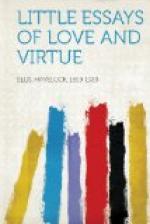The evolution of society, however, tended to overlay and sometimes even to suppress those fundamental natural tendencies. The position of the man as the sole and uncontested head of the family, the insistence on paternity and male descent, the accompanying economic developments, and the tendency to view a woman less as a self-disposing individual than as an object of barter belonging to her father, the consequent rigidity of the marriage bond and the stern insistence on wifely fidelity—all these conditions of developing civilisation, while still leaving courtship possible, diminished its significance and even abolished its necessity. Moreover, on the basis of the social, economic, and legal developments thus established, new moral, spiritual, and religious forces were slowly generated, which worked on these rules of merely exterior order, and interiorised them, thus giving them power over the souls as well as over the bodies of women.
The result was that, directly and indirectly, the legal, economic, and erotic rights of women were all diminished. It is with the erotic rights only that we are here concerned.
No doubt in its erotic aspects, as well as in its legal and economic aspects, the social order thus established was described, and in good faith, as beneficial to women, and even as maintained in their interests. Monogamy and the home, it was claimed, alike existed for the benefit and protection of women. It was not so often explained that they greatly benefited and protected men, with, moreover, this additional advantage that while women were absolutely confined to the home, men were free to exercise their activities outside the home, even, with tacit general consent, on the erotic side.
Whatever the real benefits, and there is no occasion for questioning them, of the sexual order thus established, it becomes clear that in certain important respects it had an unnatural and repressive influence on the erotic aspect of woman’s sexual life. It fostered the reproductive side of woman’s sexual life, but it rendered difficult for her the satisfaction of the instinct for that courtship which is the natural preliminary of reproductive activity, an instinct even more highly developed in the female than in the male, and the more insistent because in the order of Nature the burden of maternity is preceded by the reward of pleasure. But the marriage order which had become established led to the indirect result of banning pleasure in women, or at all events in wives. It was regarded as too dangerous, and even as degrading. The women who wanted pleasure were not considered fit for the home, but more suited to be devoted to an exclusive “life of pleasure,” which soon turned out to be not their own pleasure but men’s. A “life of pleasure,” in that sense or in any other sense, was not what more than a small minority of women ever desired. The desire of women for courtship is not a thing by itself, and was not implanted for gratification by itself. It is naturally intertwined—and to a much greater degree than the corresponding desire in men—with her deepest personal, family, and social instincts, so that if these are desecrated and lost its charm soon fades.




